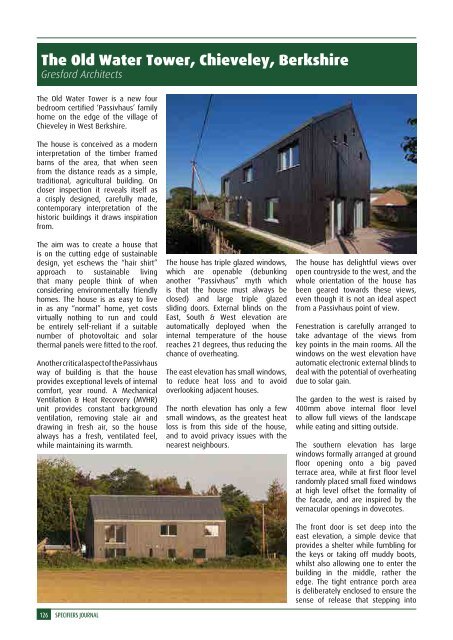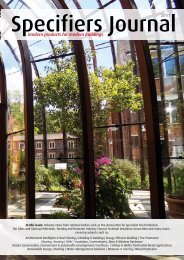Specifiers Journal 2016
Specifiers Journal 2016
Specifiers Journal 2016
Create successful ePaper yourself
Turn your PDF publications into a flip-book with our unique Google optimized e-Paper software.
The Old Water Tower, Chieveley, Berkshire<br />
Gresford Architects<br />
The Old Water Tower is a new four<br />
bedroom certified ‘Passivhaus’ family<br />
home on the edge of the village of<br />
Chieveley in West Berkshire.<br />
The house is conceived as a modern<br />
interpretation of the timber framed<br />
barns of the area, that when seen<br />
from the distance reads as a simple,<br />
traditional, agricultural building. On<br />
closer inspection it reveals itself as<br />
a crisply designed, carefully made,<br />
contemporary interpretation of the<br />
historic buildings it draws inspiration<br />
from.<br />
The aim was to create a house that<br />
is on the cutting edge of sustainable<br />
design, yet eschews the “hair shirt”<br />
approach to sustainable living<br />
that many people think of when<br />
considering environmentally friendly<br />
homes. The house is as easy to live<br />
in as any “normal” home, yet costs<br />
virtually nothing to run and could<br />
be entirely self-reliant if a suitable<br />
number of photovoltaic and solar<br />
thermal panels were fitted to the roof.<br />
Another critical aspect of the Passivhaus<br />
way of building is that the house<br />
provides exceptional levels of internal<br />
comfort, year round. A Mechanical<br />
Ventilation & Heat Recovery (MVHR)<br />
unit provides constant background<br />
ventilation, removing stale air and<br />
drawing in fresh air, so the house<br />
always has a fresh, ventilated feel,<br />
while maintaining its warmth.<br />
126 SPECIFIERS JOURNAL<br />
The house has triple glazed windows,<br />
which are openable (debunking<br />
another “Passivhaus” myth which<br />
is that the house must always be<br />
closed) and large triple glazed<br />
sliding doors. External blinds on the<br />
East, South & West elevation are<br />
automatically deployed when the<br />
internal temperature of the house<br />
reaches 21 degrees, thus reducing the<br />
chance of overheating.<br />
The east elevation has small windows,<br />
to reduce heat loss and to avoid<br />
overlooking adjacent houses.<br />
The north elevation has only a few<br />
small windows, as the greatest heat<br />
loss is from this side of the house,<br />
and to avoid privacy issues with the<br />
nearest neighbours.<br />
The house has delightful views over<br />
open countryside to the west, and the<br />
whole orientation of the house has<br />
been geared towards these views,<br />
even though it is not an ideal aspect<br />
from a Passivhaus point of view.<br />
Fenestration is carefully arranged to<br />
take advantage of the views from<br />
key points in the main rooms. All the<br />
windows on the west elevation have<br />
automatic electronic external blinds to<br />
deal with the potential of overheating<br />
due to solar gain.<br />
The garden to the west is raised by<br />
400mm above internal floor level<br />
to allow full views of the landscape<br />
while eating and sitting outside.<br />
The southern elevation has large<br />
windows formally arranged at ground<br />
floor opening onto a big paved<br />
terrace area, while at first floor level<br />
randomly placed small fixed windows<br />
at high level offset the formality of<br />
the facade, and are inspired by the<br />
vernacular openings in dovecotes.<br />
The front door is set deep into the<br />
east elevation, a simple device that<br />
provides a shelter while fumbling for<br />
the keys or taking off muddy boots,<br />
whilst also allowing one to enter the<br />
building in the middle, rather the<br />
edge. The tight entrance porch area<br />
is deliberately enclosed to ensure the<br />
sense of release that stepping into







